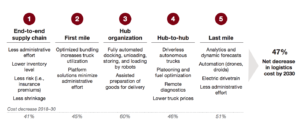Within a few short years, trucking and logistics will be an ecosystem of autonomous vehicles directed by a digitized supply chain, combining driverless, cabless trucks and delivery hubs staffed by robots. But what about the numbers behind these changes? In particular, what do they mean for cost and efficiency in the transport industry that has long sought to improve both by fine-tuning its business model?
In this, PWC latest study ‘The era of digitized trucking: Charting your transformation to a new business model’, PWC has undertaken a deep dive into these two crucial elements with a focus on the trucking sector in the European Union (E.U.) and have developed the following estimates:
- Trucking logistics costs will fall by 47 percent by 2030, largely through a reduction of labor.
- Delivery lead times will fall by 40 percent.
- Trucks will be in use on the road for 78 percent of the time, rather than the current industry average in Europe of 29 percent.
Significant stakeholders in the current system, such as long-distance truck drivers and freight-forwarding companies, will disappear; the process of matching the goods to be delivered and the available trucks will be fully automated. To stay competitive, OEMs need to expand their product portfolios to include new powertrains and focus production on autonomous long-haul trucks. Large tech companies will become a bigger feature in the delivery market, with new technologies.
Read the full report here.

